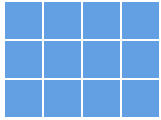 The area of a region measures how much surface it covers. It covers an area of 1 square centimetre, or 1 cm2 Here is a rectangle that is 4 cm long and 2 cm high.  It covers an area of 8 cm2.
It covers an area of 8 cm2.The area is 8 square centimetres. You can find this area by counting the square centimetres. Here is a rectangle that's also a square.  Its dimensions are 3 cm by 3 cm
Its dimensions are 3 cm by 3 cmThe length and width are both 3 centimetres long. It covers an area of 9 cm2. You can find the area of 9 square centimetres by counting them. Here's a rectangle that's 1 cm tall and 6 cm long. Its area is 6 cm2. This rectangle has an area of 12 square centimetres.  Its area is 12 cm2
Its area is 12 cm2What are the dimensions? Enter them here: length = width = Check your answers by holding the cursor over the box >>> Here's another rectangle that also has area 12 cm2.  The length is 6. Why does the width have to be 2?
The length is 6. Why does the width have to be 2? Answer here: Check your answer by holding the cursor over the box: A rectangle has area 30 cm2. What could its dimensions be?. Choose one: 3 x 12 8 x 4 6 x 5 10 x 2 Check your answer here You now have a quick method for finding the area of any rectangle:
This gives us a formula: "To find the area of a rectangle, multiply the length by the width" A = L x W This also means we don't need accurate pictures any more! Move on to page two ... |